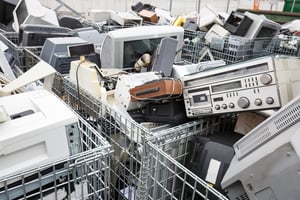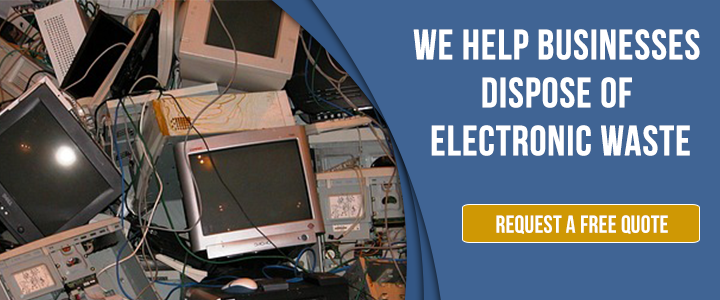Electronic waste consists of electronic devices that are near or at the end of their useful life.
As technological advancements continue, and companies adopt an “out with the old, in with the new” frame of mind to compete in their competitive industries, electronic waste has become a serious problem.
E-waste is one of the fastest growing solid waste streams in the world. Globally, businesses and individuals generated an estimated 62 million tonnes of e-waste in 2022. That’s up 82% from 2010, and electronic waste is on track to go up another 32% to 82 million tonnes by 2030, according to the United Nations Institute for Training and Research. Less than a quarter of that was documented as being collected and recycled.
The United States alone tosses 6.9 million tons each year.
What is electronic waste, and what types of waste are most commonly found in your workspace? Below we’ll explore these questions, as well as how to properly dispose of it so that you can ensure the electronics your company uses do not leave a heavy toll on the environment.
Types Of Electronic Waste
Also known as e-waste or end-of-life (EOL) electronic devices, electronic waste includes a wide variety of products. 
At home and in the office, examples of electronic waste include:
- Televisions
- CD players, DVD players and VCRs
- Flashlights
- Large and small appliances
- Cell phones
- Some toys
- Computer monitors and towers
- Printers
- Keyboards
- Calculators
- Lamps
Many manufacturing and industrial settings produce a significant amount of electronic waste, from circuit boards to power supply units. In hospitals, e-waste streams may include lab equipment, computers, servers, tablets and televisions, to name a few.
Computer waste is among the most commonly generated electronic waste. But what is computer waste versus other types of e-waste? Computer waste refers specifically to discarded components and devices related to personal computers and workstations. This includes desktops, laptops, monitors, keyboards, mice, motherboards, graphics cards and hard drives.
Unlike other types of e-waste, computer waste is often generated in large volumes by offices, schools and tech-related industries. Because many of these components contain hazardous materials like lead, mercury and cadmium, proper recycling and disposal are essential to prevent environmental harm and data security risks..
The Toll Of Electronic Waste
E-waste is connected to several health risks, especially if someone comes in direct contact with the heavy metals and other materials often found in electronics.
other materials often found in electronics.
These include:
- Lead
- Cadmium
- Chromium
- Brominated flame retardants
- Polychlorinated biphenyls (PCBs)
In California, the law states non-functioning cathode-ray tubes (CRTs) from pieces of equipment like computer monitors and televisions are considered hazardous as well because they contain lead. Even computers and television screens can contain leaded glass.
Batteries found in electronics can contain cancer-causing elements, such as cadmium, lithium and lead, and appliances like hot water heaters contain mercury switches. Mercury, in particular, can cause serious health issues like respiratory and skin disorders.
When improperly disposed of, these substances can accumulate in soil and water, causing the absorption of hazardous chemicals and the creation of by-products that can negatively impact human health.
However, many electronic devices also contain several valuable elements, such as gold, silver, copper, cobalt, and others. According to the U.S. Environmental Protection Agency, 1 metric ton of circuit boards can include up to 800 times the amount of gold that is mined from 1 metric ton of ore.
It should be no surprise then that experts estimate that recoverable materials from global e-waste were worth more than $91 billion. Yet, only a fraction of those materials were recycled and instead were dumped in landfills.
The Toll of Computer Waste
Computer waste plays a significant role in the growing problem of the discarding of tons of e-waste. With over 300 million computers used in the United States alone and more than 2 billion worldwide, the rate at which they are replaced (often every 3 to 5 years) means a massive volume of outdated or broken machines enters the waste stream annually.
These discarded computers contain many of the same hazardous substances found in other electronics, including lead from solder and cathode-ray tubes, lead and cadmium in circuit boards and semiconductors, and brominated flame retardants in plastic casings and cables. When these toxic materials are improperly discarded, they can leach into the environment, contaminating air, water and soil.
The environmental toll is compounded by the energy and resources used to manufacture computers in the first place. From mining rare earth elements to the energy-intensive production of microchips and displays, each computer represents a considerable environmental footprint before it even powers on. Recycling computers not only helps prevent toxic pollution but also allows for the recovery of valuable materials like aluminum, copper and precious metals, reducing the need for further resource extraction.
Yet despite these benefits, many discarded computers end up in landfills or are shipped overseas, where they may be dismantled under unsafe conditions and harmful materials are released into the environment. Tackling computer waste items is a critical step in reducing the overall burden of e-waste and protecting both environmental and human health.
How To Dispose Of Electronic Waste
Adding to the challenge of managing e-waste is that the lifespan of electronic devices is decreasing. Because.png?width=300&height=251&name=Insurance%20Solutions%20(18).png) companies often plan for this by requiring electronics to have updated software to function properly, discontinued older models are discarded.
companies often plan for this by requiring electronics to have updated software to function properly, discontinued older models are discarded.
Often, it’s even more cost-efficient for a company to buy a completely new product than to repair the one it has.
It almost seems inevitable that the discarding of electronic waste will continue and grow as technology continues to evolve. However, there are procedures you can put into place to ensure your electronics are safely disposed of or enjoy a longer lifespan.
The California Department of Resources Recycling and Recovery recommends that companies use a “Reduce, Reuse, Recycle” approach to reduce potential hazards. This recycling process approach urges companies to:
- Reduce e-waste through good maintenance and procurement.
- Reuse by donating or selling functional equipment.
- Recycle any products that cannot be used again (even when repaired) through certified electronic recyclers.
To properly dispose of your e-waste, certified hazardous waste companies that specialize in electronic waste disposal will help manage the recycling of your electronics.
Not working with a reputable company can result in disastrous consequences for your business, since you are subject to local, state and federal regulations regarding disposal of e-waste.
Certified technicians not only know the legal regulations you must follow but have expert knowledge in the different handling procedures for different electrical units.
Bottom Line
E-waste encompasses a wide variety of electronics, from the phones that you use every day to computers, appliances, lamps and circuit boards.
There are no indications that the trend to replace equipment with their fastest and most up-to-date versions will change anytime soon. That’s why properly disposing of recycling electronic waste is critical, since so many pieces contain substances harmful to human and environmental health.
It’s also important to keep in mind that many electronic products store sensitive data. Before recycling your equipment, be sure to remove any sensitive information from its memory. Software professionals can assist with cleaning off your drive.


Comment